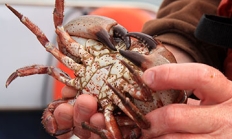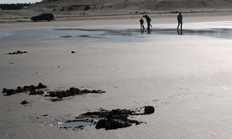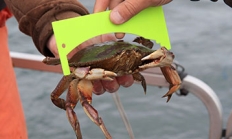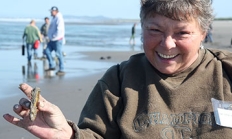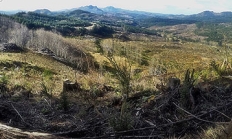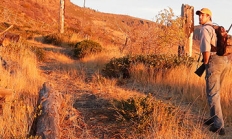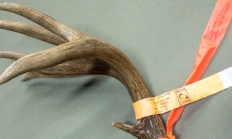Search myodfw.com
Features: This species is relatively thin compared to other rockfish. It is easily recognized by its three to four horizontal green stripes that extend onto the caudal fin membranes. The body color ranges from white to reddish; red or orange areas can be observed on the body after capture. Habitat: Though found between 40 and 1,632 foot depths, these rockfish tend to stay between 300 and 825 feet with older/larger individuals found deeper. They live on muddy, sandy and rocky bottoms. Technique: Rubber tail jigs or shrimp flies are good choices when targeting greenstriped rockfish. Be wary of sharp dorsal
Features: Olive brown to red on back, silvery-red to pink on sides. Lower jaw is long and extends at least to the eye socket. Short second anal fin spine. These fish can grow up to 3 feet long. Habitat: Most common between 160 and 820 feet deep. Adults show a preference to stay close to their home swatch of rocky bottoms or outcrops. Technique: Their diet consists of invertebrates and small fishes – try a lure that mimics these sea creatures.
Features: These fish are dark green, gray or brown on top with an off-white belly and silver or tan sides. The underside of the head and fins can be pinkish. Long second anal fin spine. Silvergrays can be confused with bocaccio rockfish which have a short second anal fin spine. Habitat: Most commonly found between 330 and 990 feet though subadults have been found in kelp beds only 56 feet deep. Adults live over various rocky-bottom habitats. Technique: Work rubber tail jigs or shrimp flies through the schools containing these fish.
Oregon clams include the much-prized razor clam, as well as bay clams -- a catch-all term that includes several different species of clams. Bay clams are widely distributed on the coast, while razor clams are concentrated on the north coast beaches in Clatsop county. Crabbers mostly target Dungeness crab, but also encounter red rock crab. It, too, is fine table fare. Crab species Clam species
Oregon's crabbing and clamming zones include the beaches, bays and estuaries of the northwest and southwest zones, the mouth of the Columbia River, and the ocean itself for ocean crabbing. Visit e-regulations
Crabbing and clamming are year-round activities on the Oregon coast. Clam diggers will want to watch for low tides, when more beach is exposed for digging. Crabbers will have the best luck during slack tide when crabs are walking about foraging. Visit e-regulations
Shellfish licenses are valid from Jan. 1 to Dec. 31. You can begin buying your next year's license on Dec. 1 of the prior year. If you have questions, please call ODFW licensing staff at 503-947-6101.
Big game hunting opportunities in Oregon are many and diverse -- from general season hunts for deer and elk, to controlled hunts for deer, elk, antelope, bear and cougar, to once-in-a-lifetime chances for bighorn sheep and Rocky Mountain goat.
Oregon's diverse habitats and terrain offers something for every hunter. From the densely forested Coast Range to the expansive sage steppe of the Great Basin, hunting opportunities are practically unlimited. Visit e-regulations
August, September and October are the months when most big game hunters will be in the woods or on the grasslands. Many hunters have long-standing traditions of deer or elk camp spent with family and friends. Visit e-regulations
Hunting licenses are valid from Jan. 1 to Dec. 31. You can begin buying your next year's license on Dec. 1 of the prior year. If you have questions, please call ODFW licensing staff at 503-947-6101.



Three Mile Falls Dam is located at river mile three on the Umatilla River. The dam was constructed in the early 1900s and serves as an irrigation dam that is a complete barrier to fish migrating upstream. In order to successfully migrate past the dam, all adult salmon and steelhead must use the fish passage facility located on the east side of the dam. The fish facility consists of a fish ladder, viewing window, fish trap and holding pond. Every adult salmon and steelhead heading upstream is counted at this facility using a combination of trapping and video tape enumeration
While there is a general, statewide season for cougars, there are quotas set by zone. Once a quota in a certain zone is met, that zone will close for cougar hunting. Below are the most recent numbers on cougar harvest by zone.

